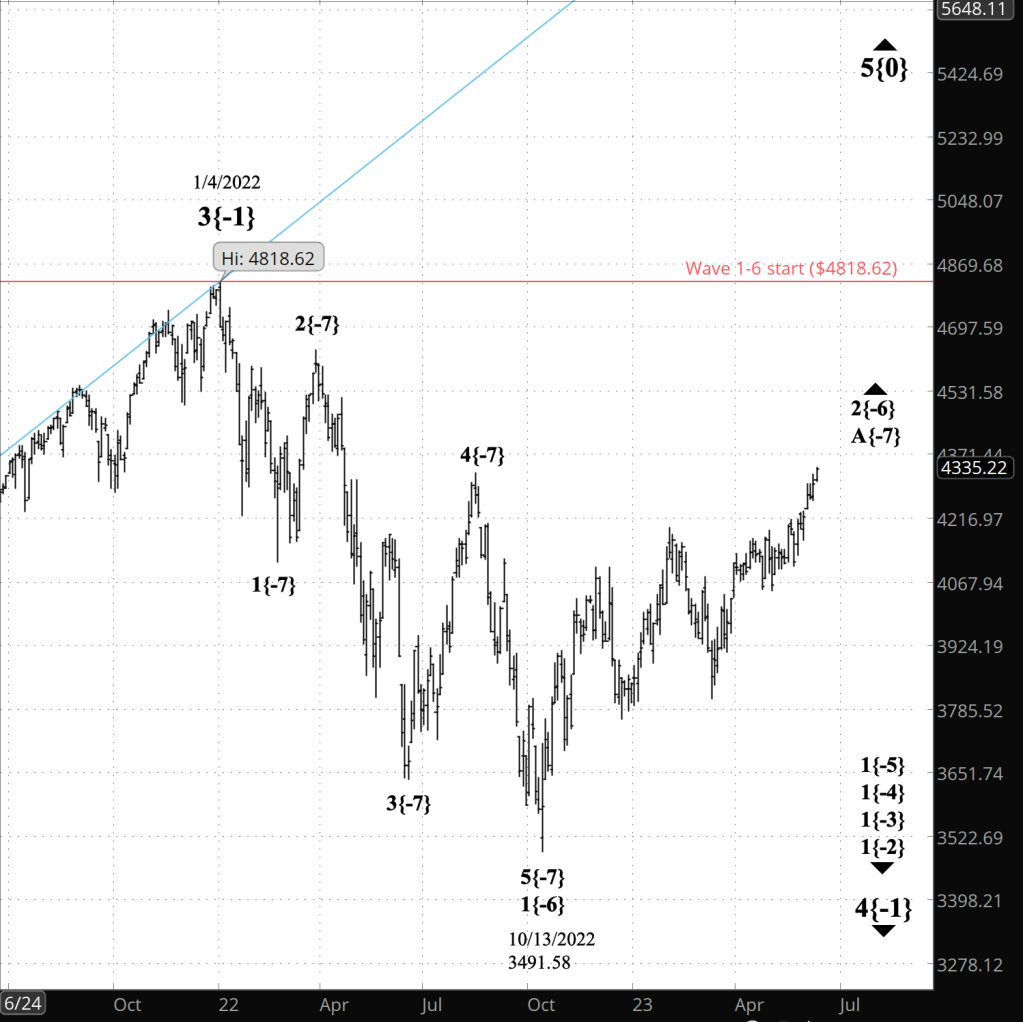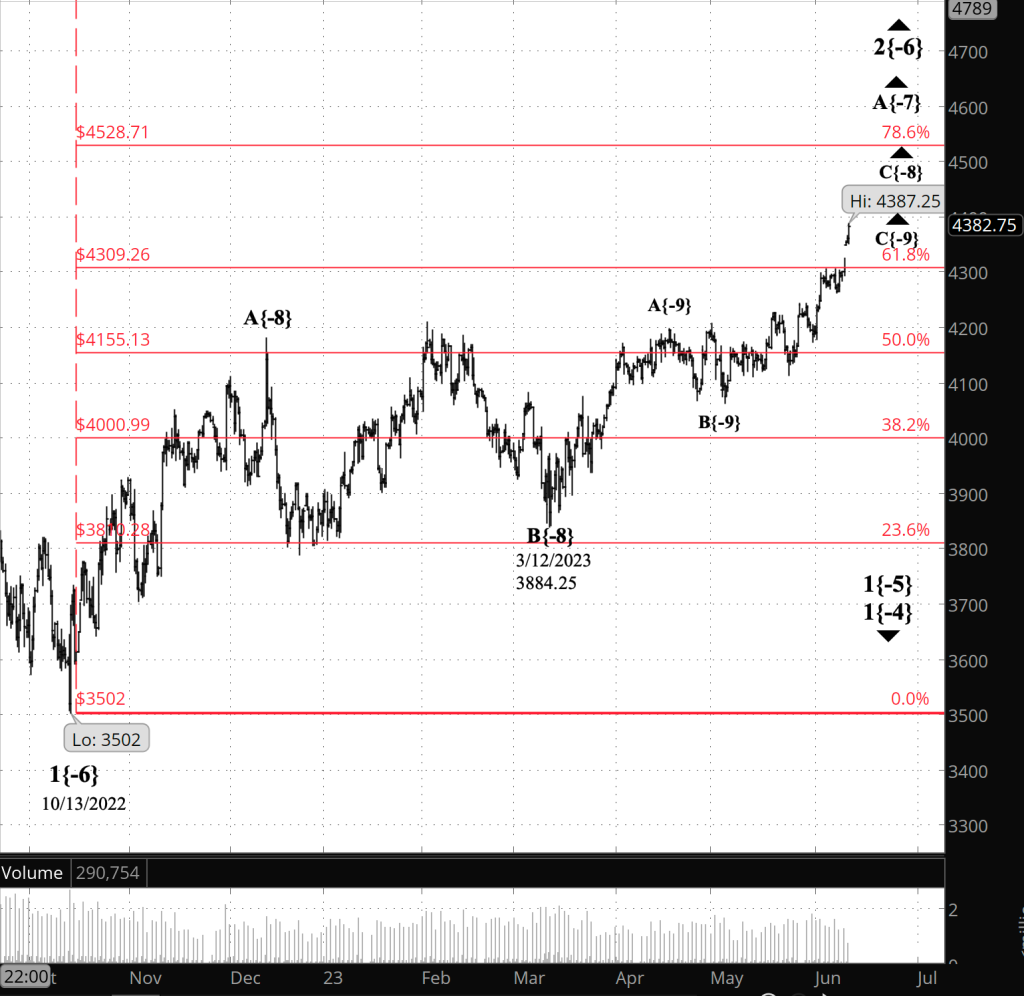3:30 p.m. New York time
Half an hour before the closing bell. The S&P 500 futures rose slightly higher during the session, into the 4380s so far. The rise brought the 2nd wave upward correction to a 61.8% Fibonacci retracement of the downtrending 1st wave that preceded it. The neighborhood of 61.8% is in my experience a common ending point for a price movement. The preceding downtrend, wave 1{-6}, began on January 4, 2022 from 4808.25. The present upward correction, wave 2{-6}, began on October 13, 2022 from 3502.
There’s no change in the analysis. This morning’s chart labeled the price of the starting point of the upward correction incorrectly, and I’ve fixed that. I’ve also added a Fibonacci retracement ladder, in red, to the futures chart and have updated both charts to show the price movements during the session.
9:35 a.m. New York time
New to Elliott wave theory? The topic of today’s Trader’s Notebook requires extensive use of Elliott wave terminology. See the “Reading the chart” section, below, for guidance on how to read the jargon, both in the text and on the chart.
What’s happening now? The S&P 500 E-mini futures gapped up by 45 points when trading resumed overnight, and continued to rise, moving above the upper limit described in earlier analyses. The rise, a 2nd wave, has so far retraced 63% of the preceding decline, a 1st wave.
The map no longer fits the territory — the analysis no longer matches the chart — and so I’ve revised the analysis.
What does it mean? The new analysis moves everything up one degree. What had been wave 2{-7} has become wave 2{-6}, which began on October 13, 2022. The new parent wave is wave 1{-5}, which began on January 4, 2022.
The reanalysis sets new upper limits, based on a rule of Elliott wave theory that says a 2nd wave never reaches beyond the beginning of the preceding 1st wave.
The new upper limit is the beginning of wave 1{-6}. The wave 2{-6} upper limit of the S&P 500 futures was raised from the old limit, 4327.50, to the new one, 4808.25, and the S&P 500 index limit was raised from 4325.28 to 4818.62.
When wave 2{-6} is complete, it will be followed by a powerful downward correction, wave 3{-6}.
Reading the chart. I’m posting two charts today. The upper chart is of the S&P 500 index and shows the entirety of the decline from January 4, 2022, the beginning of a major downtrend that will be with us for some time to come. This chart gives context to the detailed chart below it, which shows the upward correction, now underway, that began on October 13, 2022. For a near-term view of the former analysis, see the futures chart posted last Friday, June 9. For a broader context, see the index chart posted on June 5.
Price movements — waves – – in Elliott wave analysis are labeled with numbers within trending waves and letters with corrective waves. The subscripts — numbers in curly brackets — designate the wave’s degree, which, in Elliott wave analysis, means the relative position of a wave within the larger and smaller structures that make up the chart. R.N. Elliott, who in the 1930s developed the form of analysis that bears his name, viewed the chart as a complex structure of smaller waves nested within larger waves, which in turn are nested within still larger waves. In mathematics it’s called a fractal structure, where at every scale the pattern is similar to the others.
What are the alternatives? When revisions of the analysis become necessary, it is almost always a question of the degree of a wave. Waves don’t come with introductory lapel buttons saying, “Hi! My degree is…” The way to determine a degree is to figure out what previous degree’s size the present wave seems to match. There’s a lot of ambiguity, and very little certainty. This revision took what had been labeled wave 2{-7} and moved it up a degree, to wave 2{-6}, and made the other adjustments required by that new analysis.
The same ambiguity that applied to the earlier analysis also applies to this one. I’ve taken a guess that the degree is {-6}. It could eventually turn out to be another degree.

[S&P 500 index at 3:30 p.m., 1-day bars, with volume]

[S&P 500 E-mini futures at 3:30 p.m., 8-hour bars, with volume]
What does Elliott wave theory say? Here are the waves that underly the revised analyses.
Principal analysis:
- An upward correction, wave 2{-6}, began on October 13, 2022 and is underway.
- The correction’s first subwave, wave A{-7}, is underway and will have five subwaves.
- Wave A{-7} at present is in its 3rd subwave, wave C{-8}.
- Wave 2{-6}, when complete, will be followed by a powerful downtrend, wave 3{-6}.
We Are Here.
These are the waves currently in progress under my principal analysis. Each line on the list shows the wave number, with the subscript in curly brackets, the traditional degree name, the starting date, the starting price of the S&P 500 E-mini futures, and the direction of the wave.
- S&P 500 Index:
- 5{+3} Supercycle, 7/8/1932, 4.40 (up)
- 5{+2} Cycle, 12/9/1974, 60.96 (up)
- 5{+1} Primary, 3/6/2009, 666.79 (up)
- 5{0} Intermediate, 12/26/2018, 2346.58 (up)
- S&P 500 Futures and index:
- 4{-1} Minor, 1/4/2022, 4808.25 (down) (futures), 4818.62 (down) (index)
- S&P 500 Futures:
- 1{-2} Minute, 1/4/2022, 4808.25 (down)
- 1{-3} Minuette, 1/4/2022, 4808.25 (down)
- 1{-4} Subminuette, 1/4/2022, 4808.25 (down)
- 1{-5} Micro, 1/4/2022, 4808.25 (down)
- 2{-6} Minuscule, 10/13/2022, 3577.75 (up)
Learning and other resources. Elliott wave analysis provides context, not prophecy. As the 20th century semanticist Alfred Korzybski put it in his book Science and Sanity (1933), “The map is not the territory … The only usefulness of a map depends on similarity of structure between the empirical world and the map.” And I would add, in the ever-changing markets, we can judge that similarity of structure only after the fact.
See the menu page Analytical Methods for a rundown on where to go for information on Elliott wave analysis.
By Tim Bovee, Portland, Oregon, June 12, 2023
Disclaimer
Tim Bovee, Private Trader tracks the analysis and trades of a private trader for his own accounts. Nothing in this blog constitutes a recommendation to buy or sell stocks, options or any other financial instrument. The only purpose of this blog is to provide education and entertainment.
No trader is ever 100 percent successful in his or her trades. Trading in the stock and option markets is risky and uncertain. Each trader must make trading decisions for his or her own account, and take responsibility for the consequences.
All content on Tim Bovee, Private Trader by Timothy K. Bovee is licensed under a Creative Commons Attribution-ShareAlike 4.0 International License.
Based on a work at www.timbovee.com.

You must be logged in to post a comment.